This light works fine but when I was checking with my voltage tester to find what switch contols it, it read voltage even when the switch was off. Switch on it reads 120v and when the switch is off it reads 89v. Does this mean there is a loose neutral somewhere, but then why would the light switch and light work properly.
You are using an out of date browser. It may not display this or other websites correctly.
You should upgrade or use an alternative browser.
You should upgrade or use an alternative browser.
Troubleshooting
- Thread starter JdoubleU
- Start date
- Status
- Not open for further replies.
Induced voltage.Jakewhis said:Switch on it reads 120v and when the switch is off it reads 89v. Does this mean there is a loose neutral somewhere, but then why would the light switch and light work properly.
Here's a highly scientific study performed in a climate controlled environment:
Read all the shenanigans here:Testers used:
Ideal Circuit Tracer (Just the one piece)
Ideal Vol-Con (about 21 years old)
Fluke T2
Fluke 87
AWS Snap 8
GreenLee GT-11
....shown also is one partial roll of 14/3 NM
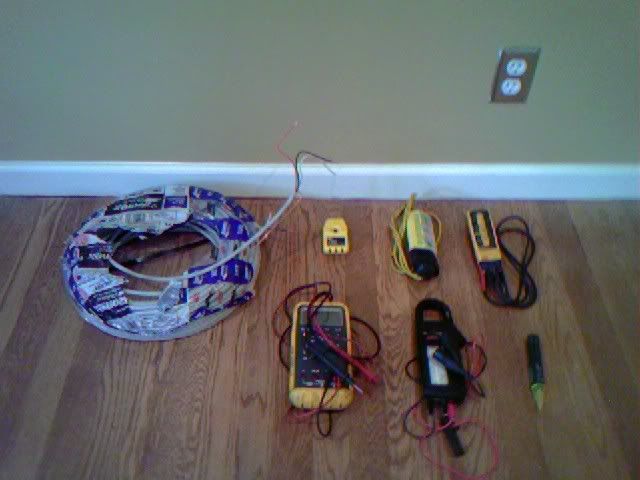
I stripped back both ends of the NM and jammed the black and white wires into a working outlet ~ the red and EGC are not connected to anything...using the Ideal Tracer to show that the recept is HOT:
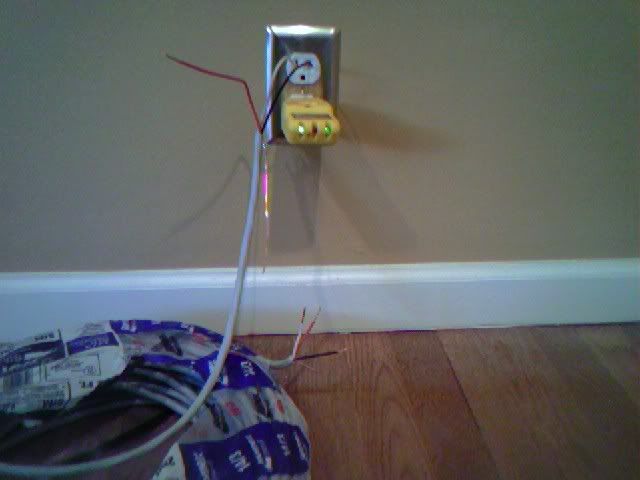
Next...
We did NOT detect any voltage with the Vol-Con:
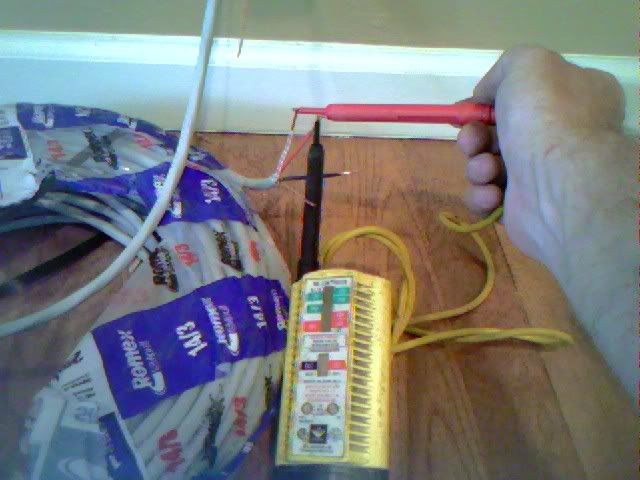
Next....
We sensed a voltage using the Fluke T2:
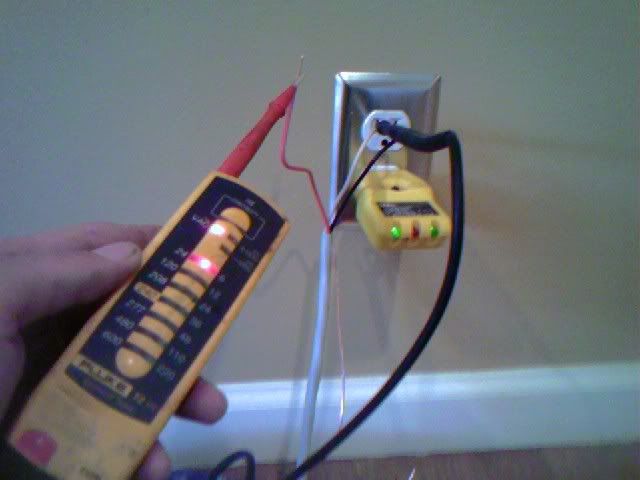
Next....
We sensed a voltage using the Fluke 87:
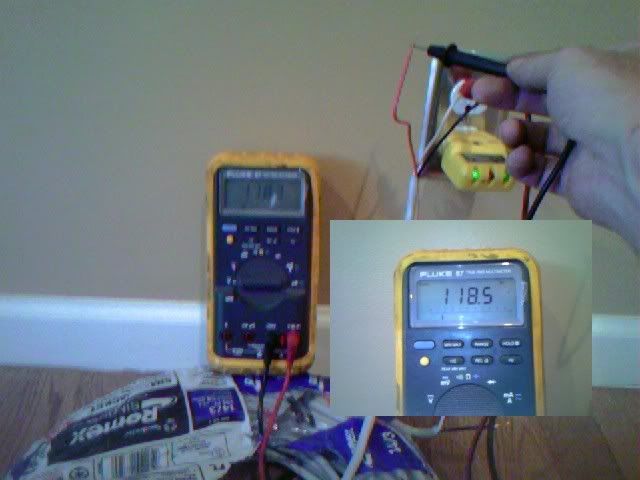
Next...
We did NOT detect any voltage with the Snap 8:

Finally....
We sensed a voltage on the red wire...on the end of the NM that was inserted into the recept. using the GreenLee GT-11:
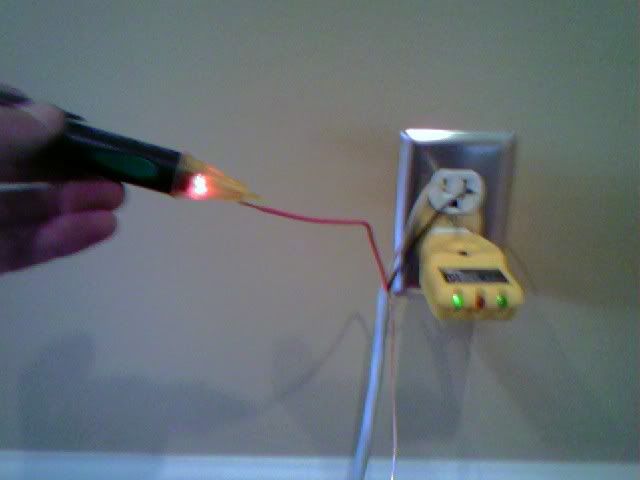
NM and induced voltage
- Location
- Illinois
- Occupation
- retired electrician
With the load side of the switch connected to a load, you should not read much voltage between the switch leg and the grounding conductor. You should read full voltage beween the switch leg and the supply conductor.
Thats why I always prefer a loaded meter (wiggie) to test AC circuits so you are not reading induced voltages without potential.
Note; Your test using the NM maximizes the induction because it is a roll and works like a transformer. It's much less when cables are layed out flat.
Note; Your test using the NM maximizes the induction because it is a roll and works like a transformer. It's much less when cables are layed out flat.
S'mise said:Note; Your test using the NM maximizes the induction because it is a roll and works like a transformer. It's much less when cables are layed out flat.
Not that much less.
Interesting test thank you for sharing it with me.celtic said:Induced voltage.
Here's a highly scientific study performed in a climate controlled environment:
Read all the shenanigans here:
NM and induced voltage
ohm
Senior Member
- Location
- Birmingham, AL
celtic said:Induced voltage.
Here's a highly scientific study performed in a climate controlled environment:
Read all the shenanigans here:
NM and induced voltage
Excellent demo Celtic. It's ironic that the most expensive piece of test equipment lies the most on electrical work.
When doing start-up at a chemical plant a young engineer asked why she measured nearly 120VAV on a conductor in a multipair bundle that was not connected on either end.
I took her high dollar Fluke touched one end with my finger and the other to the conductor in question. The meter read 80 VAC. She was astounded.
I asked if she would like to see it read 40 VAC..yes she did, so I raised one foot off the metal floor.
That started a long lecture on Ohm's Law and capacitive coupling.
I always put the fluke away and drag out an Ideal tester which loads down the circuit for electrical work.
iaov
Senior Member
- Location
- Rhinelander WI
Great demo Celtic!! I own a Fluke 87 but most of my trouble shooting is done with the Ideal wiggy you showed in your pictures,for the reasons you showed in your pictures.
peter d
Senior Member
- Location
- New England
ohm said:When doing start-up at a chemical plant a young engineer asked why she measured nearly 120VAV on a conductor in a multipair bundle that was not connected on either end.
An electrical engineer? Assuming it's an EE, I'm curious how an EE would not know about a basic concept like capacitance?
ohm
Senior Member
- Location
- Birmingham, AL
Actually a CE turned computer jock.peter d said:An electrical engineer? Assuming it's an EE, I'm curious how an EE would not know about a basic concept like capacitance?
ohm said:I asked if she would like to see it read 40 VAC..yes she did, so I raised one foot off the metal floor.
That started a long lecture on Ohm's Law and capacitive coupling.
I always put the fluke away and drag out an Ideal tester which loads down the circuit for electrical work.
On of my navy instructors said once, your bodies capacitance is directly proportional to your shoe size,,,ie-air core capacitor.
that was rather interesting of a post.
wirenut1980
Senior Member
- Location
- Plainfield, IN
peter d said:An electrical engineer? Assuming it's an EE, I'm curious how an EE would not know about a basic concept like capacitance?
I will say it is one thing to learn about inductance and capacitance in a classroom, and another thing to apply it to the situation described.
wirenut1980 said:I will say it is one thing to learn about inductance and capacitance in a classroom, and another thing to apply it to the situation described.
my thoughts exactly,,
I was talking with a young EE recently and was shooting the breeze about dopping of transitors, He had no clue what chemical science created the .3v or .6v drop.
I honestly think a lot of BEE is getting put on the shelf and forgot about.
LarryFine
Master Electrician Electric Contractor Richmond VA
- Location
- Henrico County, VA
- Occupation
- Electrical Contractor
Do you mean 'doping' of 'transistors' and the P-N junction voltage drop?jcassity said:I was talking with a young EE recently and was shooting the breeze about dopping of transitors, He had no clue what chemical science created the .3v or .6v drop.
LarryFine said:Do you mean 'doping' of 'transistors' and the P-N junction voltage drop?
yes, the depletion region for rev or fwd bias using boron or arsnic (thier k shell available electrons)., whch defines a silcone or germanium diode.
peter d
Senior Member
- Location
- New England
wirenut1980 said:I will say it is one thing to learn about inductance and capacitance in a classroom, and another thing to apply it to the situation described.
Yes, but it's quite easy to do a real life demonstration of capacitance in the classroom using nothing more than a DMM and a dry erase board. Insert one probe into the outlet and touch the other probe. Touch probe and dry erase board at the same time and you an get some pretty high readings on the DMM.
LarryFine
Master Electrician Electric Contractor Richmond VA
- Location
- Henrico County, VA
- Occupation
- Electrical Contractor
Now, let's see you do the same thing with a wiggy. :wink:peter d said:Yes, but it's quite easy to do a real life demonstration of capacitance in the classroom using nothing more than a DMM and a dry erase board. Insert one probe into the outlet and touch the other probe. Touch probe and dry erase board at the same time and you an get some pretty high readings on the DMM.
- Status
- Not open for further replies.

